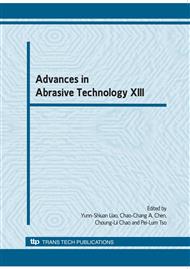[1]
J. Luo, D. A. Dornfeld, Optimization of CMP from the viewpoint of consumable effects, Journal of the Electrochemical Society, Vol. 150, No. 12, pp. G807-G815 (2003).
DOI: 10.1149/1.1623771
Google Scholar
[2]
J. Luo, Wafer-scale CMP modeling of with-in wafer non-uniformity, Annual Research Report of LMA, Department of Mechanical Engineering, University of California at Berkeley, Berkeley, CA, U.S.A. (2000).
Google Scholar
[3]
Tyan Feng, Nonuniformity of wafer and pad in CMP: Kinematic Aspects of View, IEEE TRANSACTIONS ON SEMICONDUCTOR MANUFACTURING, VOL. 20, NO. 4 (2007).
DOI: 10.1109/tsm.2007.907625
Google Scholar
[4]
W. T. Tseng and Y. L. Wang, Re-examination of pressure and speed dependence of removal rate during chemical mechanical polishing processed, Journal of the Electrochemical Society, 144, L15-L17 (1997).
DOI: 10.1149/1.1837417
Google Scholar
[5]
K. Pak, Y. R. Park,U. L. Chung Y.B. Koh, andM.Y. Lee, A CMP process using a fast oxide slurry, in Proceedings of the Second International Chemical Mechanical Planarization for ULSI Multilevel Interconnection Conference, pp.299-306 (1997).
Google Scholar
[6]
S. Deshpande, S. Dakshinamurthy, S. C. Kuiry, R. Vaidyanathan, Y. S. Obeng, S. Seal, Surface-modified polymeric pads for enhanced performance during chemical mechanical planarization, Thin Solid Films, vol. 483, pp.261-269 (2005).
DOI: 10.1016/j.tsf.2004.12.063
Google Scholar
[7]
J. Luo and D. A. Dornfeld, Material removal mechanism in chemical mechanical polishing: theory and modeling, IEEE Transactions on Semiconductor Manufacturing, Vol. 14, No, 2, pp.112-123 (2001).
DOI: 10.1109/66.920723
Google Scholar
[8]
J. Luo and D. A. Dornfeld, Effects of abrasive size distribution in chemical mechanical planarization: modeling and verification, IEEE Transactions on Semiconductor Manufacturing (2003).
DOI: 10.1109/tsm.2003.815199
Google Scholar
[9]
J. Luo and D. A. Dornfeld, Material removal regions in chemical mechanical planarization for submicron integrated circuit fabrication: coupling effects of slurry chemicals, abrasive size distribution, and wafer-pad contact area, IEEE Transactions on Semiconductor Manufacturing, Vol. 16, No, 1, pp.45-56 (2003).
DOI: 10.1109/tsm.2002.807739
Google Scholar
[10]
Y. -Y. Lin, S. - P. Lo, A study of a finite element model for the chemical mechanical polishing process, Int. J. Adv Manuf Technol, Vol. 23, pp.644-650 (2004).
Google Scholar
[11]
Ship-Peng Lo, Yeou-Yih Lin, Jen-Ching Huang, Analysis of retaining ring using finite element simulation in chemical mechanical polishing process, Int. J. Adv Manuf Technol, Vol. 34, pp.547-555 (2007).
DOI: 10.1007/s00170-006-0622-3
Google Scholar
[12]
Yang. Wei, Guo. YinBiao, Xu. Qiao, Li. YaGuo, Edge effects on material removal amount in ultra precise polishing process, Qiangjiguang Yu Lizishu/High Power Laser and Particle Beams, v 20, n 10, pp.1653-1657 (2008).
Google Scholar


